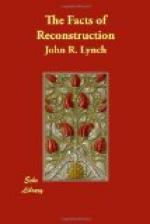Of the Republican membership of the Constitutional Convention a large majority were white men,—many of them natives of the State and a number of others, though born elsewhere, residents in the State for many years preceding the war of the Rebellion. My own county, Adams (Natchez), in which the colored voters were largely in the majority, and which was entitled to three delegates in the convention, elected two white men,—E.J. Castello, and Fred Parsons,—and one colored man, H.P. Jacobs, a Baptist preacher. Throughout the State the proportion was about the same. This was a great disappointment to the dominating element in the Democratic party, who had hoped and expected, through their policy of “Masterly Inactivity” and intimidation of white men, that the convention would be composed almost exclusively of illiterate and inexperienced colored men. Although a minor at that time, I took an active part in the local politics of my county, and, being a member of a Republican club that had been organized at Natchez, I was frequently called upon to address the members at its weekly meetings.
When the State Constitution was submitted to a popular vote for ratification or rejection I took an active part in the county campaign in advocacy of its ratification. In this election the Democrats pursued a course that was just the opposite of that pursued by them in the election of delegates to the Constitutional Convention. They decided that it was no longer unwise and dangerous for white men to take part in an election in which colored men were allowed to participate. This was due largely to the fact that the work of the convention had been far different from what they had anticipated. The newly framed Constitution was, taken as a whole, such an excellent document that in all probability it would have been ratified without serious opposition but for the fact that there was an unfortunate, unwise and unnecessary clause in it which practically disfranchised those who had held an office under the Constitution of the United States and who, having taken an oath to support and defend the Constitution of the United States, had afterwards supported the cause of the Confederacy. This clause caused very bitter and intense opposition to the ratification of the Constitution. When the election was over it was found that the Constitution had been rejected by a small majority. This result could not be fairly accepted as an indication of the strength of the two parties in the State, for it was a well-known fact that the Republican party had a clear majority of about 30,000.
Notwithstanding the large Republican majority in the State, which was believed to be safe, sure and reliable, there were several causes that contributed to the rejection of the newly framed Constitution. Among the causes were:
First. In consequence of the bitterness with which the ratification of the Constitution had been fought, on account of the objectionable clause referred to, intimidating methods had been adopted in several counties in which there was a large colored vote, resulting in a loss of several thousand votes for the Constitution.




